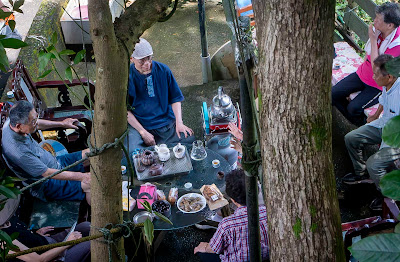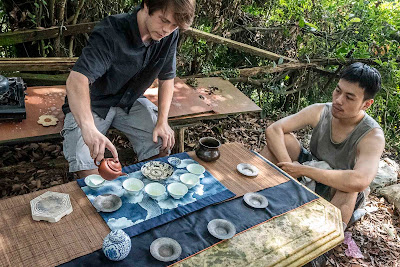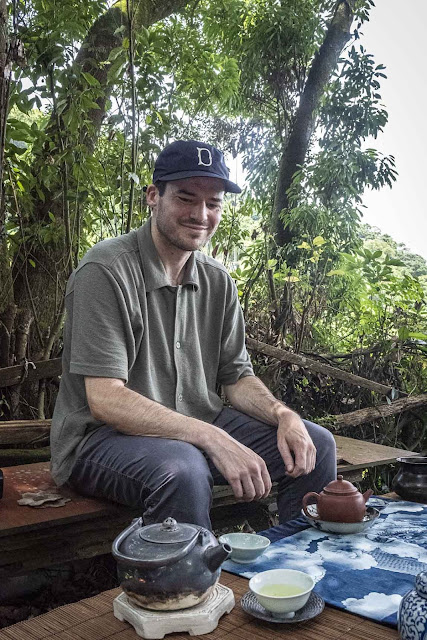 |
| 2024 spring Lily Flower Wenshan Baozhong |
It's summer, the best season to enjoy tea outdoors! We chose to brew early, because summer is the season of afternoon showers in Taiwan. We started with this lightly oxidized Wenshan because I like to start with a regional tea. Drinking a Baozhong south of Taipei helps to understand the connection between a tea and its terroir. This tea could have come from a nearby tea plantation. So, the aromas that exude from the cup are very similar to the scents in these hills. The trick, outdoors, with a Wenshan Baozhong is to brew it quite strong. You can see that the leaves are plenty and that they opened up very well in the porcelain gaiwan. My 4 guests wondered what's my secret to get the first brew to open up: "the secret will be revealed in due time. Patience is one important factor."
The second tea we brewed is my spring 2024 Da Yu Ling 100K high mountain Oolong. I switched to a larger Yixing zhuni teapot, because it's such a fine tea. It needs more space to expand. Here, I had to be careful to find the right amount of leaves for a well balanced brew. There are more distractions outdoors (smells, sounds, wind...) so that you should brew stronger. However, with this level of quality, you don't want to lose the finesse of the high mountain taste. So it can't be too strong either. My guests thought I made a terrific job. They enjoyed the minerality of the powerful aftertaste. Even the blue dragon seemed to smile...
By coincidence, another tea party started just a couple of feet away from us. I'm posting this picture because it is quite typical of the way the Taiwanese enjoy their tea.
You'll notice several differences with my set up:
He handled the zhuni teapot very well, though, and Robert recorded him on his phone.
See, there are very few splashes on the Chabu! Nick is happy!
Very happy!
Then Kevin performed the third brew. He's a Taiwanese tea friend with a lot of tea experience. A friend of Nick, I met him for the first time for this occasion.
We can see that he performed his task with concentration.
Thank you, Kevin!
Then Robert, a German studying Chinese brewed the fourth brew with the silver kettle. Actually, I had also brought a stainless kettle to boil water, but after we compared the hot water coming from both kettles, we all preferred the sweeter, purer and energetic taste of the water boiled in silver.
For high mountain Oolong, it's helpful to pour some boiling water also ON the teapot. It helps get more aromas out of the leaves.
Good job, Robert! Vielen Dank! Sorry I caught you when you closed your eyes.
After Da Yu Ling, we switched to my spring 2024 charcoal roasted qingxin Oolong from Young Lung in the Dong Ding region. I placed this tea at the end, because it's taste and scents are heavier then the first 2 teas and there should be a progression. The charcoal roast, especially, added another dimension to the Oolongs we've had so far.
My guests were familiar with the competition Dong Ding Oolongs, but found this Dong Ding Oolong to taste different. Its roast has no burnt scents and the leaves open up completely. Here I will now reveal the secret to a good first brew. It's easier to brew in an Yixing teapot, because it retains heat very well. The challenge is the gaiwan. The trick is to preheat the porcelain well: don't save water by only filling half the gaiwan! And be patient enough to let the lid get hot. Finally, don't waste time and let the gaiwan cool down after emptying the water in the cups: no need to rush, but your leaves should already be ready to be put in the gaiwan and the water should already be boiling!
And then you get a beautiful golden color! Under the tree, I love how the sun and the shadow emphasize the beauty of the tea in the ivory hue tea cup.
It's now Johann's turn to brew. Handling the gaiwan is much more tricky than holding a teapot!
But Johann has lots of tea experience already and did a good job pouring the same amount of tea in each cup. The 4 tea friends asked me the question they hadn't dared ask earlier: "Why don't you use a gongdao bei, a pitcher?"
I do use one when I'm doing other things (like cooking) at the same time. However, for gongfu cha, I never use one, because the absence of a pitcher requires that you focus all your attention on the tea. That's how you manage to forget about the problems in your job/life and can enjoy tea fully. Also, it's simpler to have one fewer item to carry and to use.
Thank you Johann. Gut gemacht!
We close the circle with a last brew by Nick.
What I liked is that all these tea students knew instinctively to be silent and attentive when someone was brewing. We didn't talk about tea 90% of the time, after all. Maybe only 45%, and the other 45% were tea silences...
You won't burn your fingers if you hold the gaiwan at the rim!
I can get tea satisfaction!
I wish you a wonderful summer. You still have a couple of days to enjoy the special discount of 20% on 20 teas and 20 tea accessories. This promotion for the 20th anniversary of the blog will end on June 30th.
- a larger teapot (but also an Yixing, albeit a zisha, not necessarily the best match with fresh Oolong)
- the use of 2 pitchers for convenience.
- fruits and various snacks are displayed on the tea table and the drinkers will eat them during the tea.
There's another difference that can only be heard: their conversation was 10% about tea and 90% about other stuff. Our conversation was 90% about tea and 10% other stuff!
I let Nick handle the second brew of the DYL. Nick is a Penn State student, member of the GongFu Cha tea club. He had never me, but had read all the accounts of the various Tea Exhibitions I helped translate with TeaParker. I'm glad I was able to give him some advice to improve his brewing technique.He handled the zhuni teapot very well, though, and Robert recorded him on his phone.
See, there are very few splashes on the Chabu! Nick is happy!
Very happy!
Then Kevin performed the third brew. He's a Taiwanese tea friend with a lot of tea experience. A friend of Nick, I met him for the first time for this occasion.
We can see that he performed his task with concentration.
Thank you, Kevin!
Then Robert, a German studying Chinese brewed the fourth brew with the silver kettle. Actually, I had also brought a stainless kettle to boil water, but after we compared the hot water coming from both kettles, we all preferred the sweeter, purer and energetic taste of the water boiled in silver.
For high mountain Oolong, it's helpful to pour some boiling water also ON the teapot. It helps get more aromas out of the leaves.
Good job, Robert! Vielen Dank! Sorry I caught you when you closed your eyes.
After Da Yu Ling, we switched to my spring 2024 charcoal roasted qingxin Oolong from Young Lung in the Dong Ding region. I placed this tea at the end, because it's taste and scents are heavier then the first 2 teas and there should be a progression. The charcoal roast, especially, added another dimension to the Oolongs we've had so far.
 |
| 2024 spring charcoal roasted Oolong from Yong Lung |
And then you get a beautiful golden color! Under the tree, I love how the sun and the shadow emphasize the beauty of the tea in the ivory hue tea cup.
It's now Johann's turn to brew. Handling the gaiwan is much more tricky than holding a teapot!
But Johann has lots of tea experience already and did a good job pouring the same amount of tea in each cup. The 4 tea friends asked me the question they hadn't dared ask earlier: "Why don't you use a gongdao bei, a pitcher?"
I do use one when I'm doing other things (like cooking) at the same time. However, for gongfu cha, I never use one, because the absence of a pitcher requires that you focus all your attention on the tea. That's how you manage to forget about the problems in your job/life and can enjoy tea fully. Also, it's simpler to have one fewer item to carry and to use.
Thank you Johann. Gut gemacht!
We close the circle with a last brew by Nick.
What I liked is that all these tea students knew instinctively to be silent and attentive when someone was brewing. We didn't talk about tea 90% of the time, after all. Maybe only 45%, and the other 45% were tea silences...
You won't burn your fingers if you hold the gaiwan at the rim!
I can get tea satisfaction!
I wish you a wonderful summer. You still have a couple of days to enjoy the special discount of 20% on 20 teas and 20 tea accessories. This promotion for the 20th anniversary of the blog will end on June 30th.

































No comments:
Post a Comment